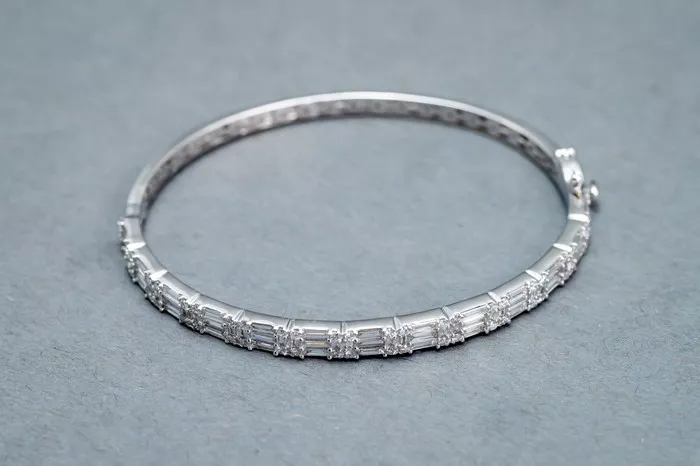A diamond tennis bracelet is a timeless piece of jewelry that combines elegance with sophistication. Whether you’re purchasing it for yourself or as a gift for a loved one, selecting the right size is crucial to ensuring it matches personal style and preferences. From understanding diamond sizes to evaluating quality and considering different styles, this comprehensive guide will walk you through everything you need to know to make an informed decision.
Understanding Diamond Sizes
Diamonds in tennis bracelets are typically measured in carats, which refers to the weight of the stone. Carat weight directly impacts the size of the diamonds and, consequently, the overall appearance of the bracelet. When choosing the size of your diamond tennis bracelet, consider the following factors:
Carat Weight: The total carat weight (TCW) of the bracelet determines how large and prominent the diamonds will be. Bracelets can range from delicate styles with smaller diamonds to more substantial pieces featuring larger stones.
Diamond Size: Individual diamond sizes can vary significantly within a bracelet. Common sizes range from 0.10 carats (or 3 mm diameter) up to 1.00 carat (or 6.5 mm diameter) per diamond. The choice depends on personal preference and budget.
Wrist Size: The size of the wearer’s wrist can influence how the bracelet will appear when worn. A larger wrist may accommodate a bracelet with larger diamonds without appearing overcrowded, whereas a smaller wrist might benefit from smaller diamonds to maintain proportion.
Evaluating Diamond Quality
Beyond size, the quality of the diamonds themselves is paramount in determining the overall beauty and value of a tennis bracelet. Key factors to consider include:
The 4Cs: Diamonds are graded on four main criteria: Cut, Color, Clarity, and Carat Weight. These collectively determine the diamond’s brilliance, sparkle, and overall beauty. When selecting a bracelet, prioritize high grades in these areas for the most stunning appearance.
Cut: A well-cut diamond reflects light effectively, maximizing its brilliance. Look for diamonds with excellent or very good cuts for optimal sparkle.
Color: Diamonds range from colorless to visibly tinted (usually yellowish). The less color a diamond has, the higher its grade and value. Grades D to F are considered colorless, while G to J are near-colorless and widely popular for their balance of quality and value.
Clarity: This refers to the presence of internal flaws (inclusions) and external blemishes. Bracelet diamonds should ideally have clarity grades of VS2 (Very Slightly Included) or higher, where inclusions are not visible to the naked eye.
Certification: Purchase diamonds certified by reputable gemological laboratories such as GIA (Gemological Institute of America) or AGS (American Gem Society) to ensure authenticity and quality.
See Also: Do Diamond Bracelets Have Serial Numbers?
Considering Different Styles
Tennis bracelets come in various styles to suit different tastes and occasions. Consider the following options when choosing a bracelet:
Metal Choice: Most tennis bracelets feature diamonds set in white gold, yellow gold, rose gold, or platinum. Select a metal that complements the wearer’s skin tone and matches other jewelry they regularly wear.
Setting Styles: Common setting styles include prong, bezel, and channel settings. Prong settings allow more light to enter the diamonds, enhancing their brilliance, while bezel settings offer a more secure fit and a sleek, modern look.
Flexible vs. Rigid: Traditional tennis bracelets are flexible, allowing them to conform to the wrist comfortably. Rigid bracelets, sometimes called bangles, maintain a circular shape and may feature diamonds all around or just on the top.
Customization: Many jewelers offer customization options, allowing you to personalize the bracelet with specific diamond sizes, settings, and metals. This ensures the bracelet perfectly matches the wearer’s preferences.
Budget Considerations
The cost of a diamond tennis bracelet can vary widely depending on factors such as carat weight, diamond quality, and metal type. Establishing a budget beforehand can help narrow down options and ensure you find a bracelet that meets both your aesthetic preferences and financial constraints. Keep in mind that quality should be prioritized over size alone, as a well-cut, high-quality diamond will have more brilliance and sparkle, regardless of its size.
Shopping Tips
When shopping for a diamond tennis bracelet, follow these tips to make a confident purchase:
Research Retailers: Choose reputable jewelers or online retailers known for their quality and customer service. Read reviews and testimonials to gauge their reliability.
Compare Options: Look at multiple bracelets to compare prices, styles, and diamond quality. Don’t hesitate to ask questions about certifications and return policies.
Try Before You Buy: If possible, try on the bracelet to see how it looks and feels on your wrist. This can help ensure it meets your expectations in terms of comfort and appearance.
Consider Long-Term Care: Understand the maintenance requirements of your bracelet, including cleaning and potential repairs. Many jewelers offer maintenance services to keep your bracelet looking its best.
Conclusion
Choosing the perfect diamond tennis bracelet involves careful consideration of diamond size, quality, style preferences, and budget. By understanding these factors and following the guidelines provided, you can confidently select a bracelet that will be cherished for its beauty and significance. Whether it’s for a special occasion or a daily reminder of elegance, a well-chosen tennis bracelet is a timeless investment in style and luxury.

